世界大地构造学2
大地构造学2

早期的世界地图已清楚地表明非洲和南美洲相对海岸 线的“锯齿状拟合”。远在1801年,洪堡 (A.Humboldt)及其同时代的著名科学家们已经提出, 大西洋两岸的海岸线和岩石都很相似。魏格纳首先提 出,应该用深海中的大陆坡边缘进行大陆拟合。凯里 (S.W.Carey )证明,两个大陆的外形在海面以下 2000米等深线几乎完全可以拟合。布拉德(E.Bullard) 等人借助计算机计算,发现无论用1000米或2000米等 深线拟合的结果差别不大。复原拟合工作证明,各大 陆可以通过复原形成一个超级大陆,即魏格纳所命名 的“泛大陆”。泛大陆是由冈瓦纳大陆(南方各大陆 加上印度)和劳亚大陆(北美和欧亚)组成的复合古 大陆。
魏格纳及其大陆漂移说
由于当时受对地球内部构造和动力学的知识局限, 大陆漂移和动力学机制得不到物理学上的支持。魏格 纳学说的不幸遭遇在于他倡导大陆漂移的同时却认为 大洋底的稳定。直到他去世的20年后,抛弃洋底稳定 不动的海底扩张学说提出,人们对大陆漂移的兴趣又 复萌了。 魏格纳是德国气象学家、地球物理学家,1880年11月1 日生于柏林,1930年11月在格陵兰考察冰原时遇难。 (播放电影文件)
海底扩张
50年代的海洋科学园地犹如百花盛开,海洋学 家除了海底热流测量外,还进行了海底地形测 量。这些资料和地震分布、海底火山和深海沉 积的研究结果,被普林斯顿大学的哈雷·赫斯 (Harry Hess)综合成海底扩张的模式。 赫斯用地幔对流机制来解释海底的地形标志, 他设想大洋中脊是热流上升而使海底裂开的地 方,熔融岩浆从这里喷出,推开两边的岩石形 成新的海底。
B.古气候的证据
魏格纳首次提出大陆漂移观点时,许多证据来自他对 古气候的研究。他注意到,各大陆上存在某一地质时 期形成的岩石类型出现在现代条件下不该出现的地区: 如在极地区分布有古珊瑚礁和热带植物化石;而在赤 道地区发现有古代的冰层。运用将今论古的原则,魏 格纳把冰川活动的中心放在当时的旋转极附近,而珊 瑚礁和蒸发岩分布的地带放在赤道附近,用这种方法 确定了各大陆当时的古纬度。对古纬度和现代纬度的 比较,魏格纳得出了大陆漂移的结论。
大地构造槽台学说及其评价(2)
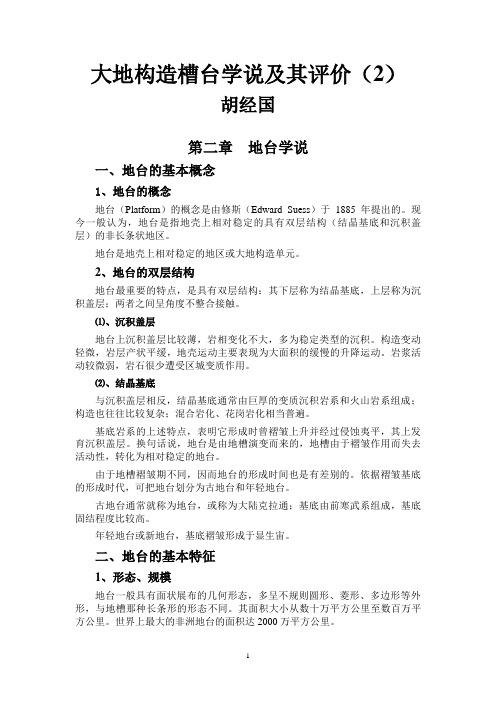
大地构造槽台学说及其评价(2)胡经国第二章地台学说一、地台的基本概念1、地台的概念地台(Platform)的概念是由修斯(Edward Suess)于1885年提出的。
现今一般认为,地台是指地壳上相对稳定的具有双层结构(结晶基底和沉积盖层)的非长条状地区。
地台是地壳上相对稳定的地区或大地构造单元。
2、地台的双层结构地台最重要的特点,是具有双层结构:其下层称为结晶基底,上层称为沉积盖层;两者之间呈角度不整合接触。
⑴、沉积盖层地台上沉积盖层比较薄,岩相变化不大,多为稳定类型的沉积。
构造变动轻微,岩层产状平缓,地壳运动主要表现为大面积的缓慢的升降运动。
岩浆活动较微弱,岩石很少遭受区城变质作用。
⑵、结晶基底与沉积盖层相反,结晶基底通常由巨厚的变质沉积岩系和火山岩系组成;构造也往往比较复杂;混合岩化、花岗岩化相当普遍。
基底岩系的上述特点,表明它形成时曾褶皱上升并经过侵蚀夷平,其上发育沉积盖层。
换句话说,地台是由地槽演变而来的,地槽由于褶皱作用而失去活动性,转化为相对稳定的地台。
由于地槽褶皱期不同,因而地台的形成时间也是有差别的。
依据褶皱基底的形成时代,可把地台划分为古地台和年轻地台。
古地台通常就称为地台,或称为大陆克拉通;基底由前寒武系组成,基底固结程度比较高。
年轻地台或新地台,基底褶皱形成于显生宙。
二、地台的基本特征1、形态、规模地台一般具有面状展布的几何形态,多呈不规则圆形、菱形、多边形等外形,与地槽那种长条形的形态不同。
其面积大小从数十万平方公里至数百万平方公里。
世界上最大的非洲地台的面积达2000万平方公里。
2、地形、地貌世界上主要的地台在地形上大多形成平原(如西伯利亚地台、俄罗斯地台、北美地台)和高原(如非洲地台、澳大利亚地台)。
地台整体高程比较一致,内部起伏较小,相对高差不大;地台没入海洋的部分往往也出现大陆架和海湾。
地台的地形多反映出老年期的地貌特征。
中国的华北地台和扬子地台,其地形较为复杂,平原与高原往往交替出现,在四周还常见较高的山脉。
第二章 第三节 大地构造学说

第三节大地构造学说大地构造学说又称地壳运动学说,是地质科学的重要理论。
其内容主要是研究地质构造的分布规律,地壳运动发生的时间、运动方式和规模,以及地壳运动的起因和动力来源。
直到现在还没有一个学说能全面完整地解释各种问题,因而可以说各家提出的多还是一些假说。
有关地壳运动及其成因的假说很多,我们主要介绍几种:(一)大陆漂移学说大陆漂移学说的提出最初主要建立在大西洋两岸地形有较好的拼合关系这个基础上,注意到这种拼接关系的可追逆到很久以前。
1620年法(培根)提出非洲与南美边界有拼合的可能(未解释)。
1858 年Ssder(斯奈德)《地球及其演化》一书中指出欧洲与北美也可以拼合在一起,并且两岸煤系地层连续。
1910美Talor(泰勒)也提出可以拼合。
这些文章注意到了两岸拼合现象,说明大陆曾可能连在一起而后又分开,但长时期内无人深入研究,没有提出一个系统的理论,直到1912年,德.魏格纳(Alfred Wegener),不仅指出两岸拼合关系,较系统的提出了“大陆漂移”学说。
1915年,Wegener的第一部论述大陆漂移理论的书《海陆的起源》问世,书中具体论述了有关大陆漂移的时间、漂移前后情况,漂移的机制,并列举了一些证据。
尽管漂移机制等后人提出了疑问,但应该说大陆漂移学说已成为了较系统的理论。
因此一般认为Wegener是大陆漂移说的创始人。
魏格纳简介1880年11月l日出生于德国柏林,喜欢幻想和冒险。
1905年,魏格纳获得了气象学博士学位。
1906年,加人了著名的丹麦探险队,到格陵兰岛从事气象和冰川调查。
最初魏格纳本人并不是地质学家,而是一名气象学家。
象这样一个地学界具有划时代意义的理论,并没产生于地质学界,如果考虑到当时的背景,应该说有其一定的必然性,当时传统的固定论思想已经统治了地学界许多年,在地质学家的思想中通常已是根深蒂固的了。
正如西方有人说过的“正因为wegener不是地质学家,没有受传统观点的束缚,所以能提出这样一个带有革命性的地质学说”。
第二章 大地构造学(板块构造理论—1板块构造理论起源)2012

的 泛 大 陆
大陆漂移学说发展遭到的阻碍
魏格纳的大陆漂移学说没有很好地解决大陆漂移的力 学机制问题,他认为,大陆漂移是硅铝质大陆壳像一座座 桌状冰山一样航行在洋底的较重的硅镁质岩浆中,并且认 为地球自转的离心力和潮汐摩擦力是推动大陆漂移的驱动 力。这些论点遭到当时多数地球物理学家们的激烈反对, 在地球物理学家们看来,洋底是坚硬的,大陆不可能像船 一样航行在洋底或硅镁层之上,地球自转的离心力和潮汐 摩擦力非常有限,远不足以推动大陆漂移。由于魏格纳的 大陆漂移学说遇到动力机制上的困难而遭到地球物理学家 们的强烈反对,加之其蕴含的活动论思想与当时地学界占 支配地位的地槽理论在思想体系上矛盾,因而,随着他本 人不幸于1930年逝世,大陆漂移假说一度销声匿迹。
1872-1876 英国挑战者号 Challenger调查
Harry Hammond Hess
H. Hess二战期间任美国太平 洋战争时期凯普.约翰逊号船 长,用声纳对海底做了不间 断的观测。 1946年发现水下平顶山。 二战后任普林斯顿大学教授, 1957年2月26日听Heezen的 报告,报导了洋脊的发现, 他当即指出:你动摇了地质 学的基石。 1960年口头发表,并于1962 年正式发表了“海盆的历史” 一文。
魏格纳和他的家人乘坐气球
• 1970在汉堡重 新命名的魏格 纳街
魏格纳有关大陆漂移的著作
• 1912a,Die Entstehung der Kontinente,Petermann’s Geographyche Mitteilungen,58,185-195,305-308. • 1912b,Die Entstehung der Kontinente,Geologische Rundschau,3,276-292 • 1915,Die Entstehung der Kontinente und Ozeane, Braunschweiz, Veiweg. • 1924,The Origin of Continents and Oceans, London: Methuen. • 1929(1966),The Origin of Continents and Oceans,
(精品word)《大地构造学》知识点总结.(良心出品必属精品)

《大地构造学》知识点总结第一章绪论一、大地构造学的研究对象、内容、方法、意义研究对象:大地构造学,是研究地球过程的综合学科。
研究内容:①区域或全球尺度的地壳与岩石圈构造变形特征及圈层相互作用,如:大洋-大陆相互作用、地球内部圈层相互作用、造山带与盆地的形成过程等;②构造变形与岩浆作用-沉积作用-变质作用的相互关系;③地壳与岩石圈的形成与演化过程;④地球表面海-陆的形成与演变方式及过程;⑤地球深部作用过程及其机制。
研究方法:大地构造学研究方法需要综合利用地质学其他学科以及地球物理探测、地球化学的研究手段与研究成果。
研究意义:大地构造学研究可以为认识和分析构造地质学的研究背景和形成机制提供宏观的上成因解释。
二、固体地球构造的主要研究方法主要包括固体构造几何学与构造运动学的研究。
固体地球的构造几何学:主要研究地球的组成成分及结构。
方法有:①研究暴露在地表的中、下层地壳乃至地幔顶部剖面,通过地质、地物、地化综合研究,揭示地壳深部物质组成、结构构造、物理性质、岩石矿物及元素的物化行为、温压条件、地热增温率、有关元素及矿物成分的聚散规律;②研究火山喷发携带到地表的深源包裹体,揭示深部物质与构造特征;③人工超深钻探直接取样(目前为止涉及最深深度12km);④地震探测:分为天然地震探测和人工地震探测,利用地震波的折射与反射可揭示地球深部构造特征。
固体地球构造运动学:主要研究地质历史时期的大地构造运动学与现今固体地球表面的构造运动。
地质历史时期的大地构造运动学可以利用古地理学(岩相、生物、构造)、古气候分区、地球物理学与古地磁学进行研究;现今固体地球表面的构造运动可以利用空间对地的观测与分析技术。
三、大地构造学研究意义理论意义:可以为认识和分析构造地质学的研究背景和形成机制提供宏观的上成因解释;实际应用意义:①大型成矿集中区(矿集区)等成矿构造背景、资源规划;②大规模破坏性地震产生于形成的地质构造背景与稳定性评价;③绝大对数大型、灾难性地震都发生在活动板块边缘带(区)上,或与板块相互作用有关的次级活动构造单元边界区域。
大地构造学基础理论提要(2)
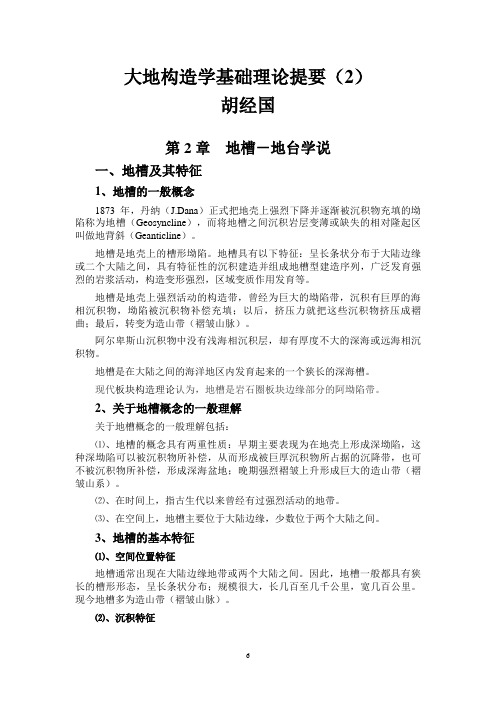
大地构造学基础理论提要(2)胡经国第2章地槽-地台学说一、地槽及其特征1、地槽的一般概念1873年,丹纳(J.Dana)正式把地壳上强烈下降并逐渐被沉积物充填的坳陷称为地槽(Geosyncline),而将地槽之间沉积岩层变薄或缺失的相对隆起区叫做地背斜(Geanticline)。
地槽是地壳上的槽形坳陷。
地槽具有以下特征:呈长条状分布于大陆边缘或二个大陆之间,具有特征性的沉积建造并组成地槽型建造序列,广泛发育强烈的岩浆活动,构造变形强烈,区域变质作用发育等。
地槽是地壳上强烈活动的构造带,曾经为巨大的坳陷带,沉积有巨厚的海相沉积物,坳陷被沉积物补偿充填;以后,挤压力就把这些沉积物挤压成褶曲;最后,转变为造山带(褶皱山脉)。
阿尔卑斯山沉积物中没有浅海相沉积层,却有厚度不大的深海或远海相沉积物。
地槽是在大陆之间的海洋地区内发育起来的一个狭长的深海槽。
现代板块构造理论认为,地槽是岩石圈板块边缘部分的阿坳陷带。
2、关于地槽概念的一般理解关于地槽概念的一般理解包括:⑴、地槽的概念具有两重性质:早期主要表现为在地壳上形成深坳陷,这种深坳陷可以被沉积物所补偿,从而形成被巨厚沉积物所占据的沉降带,也可不被沉积物所补偿,形成深海盆地;晚期强烈褶皱上升形成巨大的造山带(褶皱山系)。
⑵、在时间上,指古生代以来曾经有过强烈活动的地带。
⑶、在空间上,地槽主要位于大陆边缘,少数位于两个大陆之间。
3、地槽的基本特征⑴、空间位置特征地槽通常出现在大陆边缘地带或两个大陆之间。
因此,地槽一般都具有狭长的槽形形态,呈长条状分布;规模很大,长几百至几千公里,宽几百公里。
现今地槽多为造山带(褶皱山脉)。
⑵、沉积特征地槽沉积物分布在长条状的坳陷内。
沉积物以海相为主,分选性差,厚度巨大,可达上万米。
常常形成特殊的沉积建造和建造序列,由下而上依次为:①、硬砂岩建造这种建造多出现在地槽形成初期构造环境不稳定的情况下。
②、硅质-火山岩建造(细碧角斑岩组合)相当于蛇绿岩套的一部分,标志地槽下沉最强烈的阶段,断裂、火山活动发育。
石大自然地理学课件02地壳-3大地构造学说
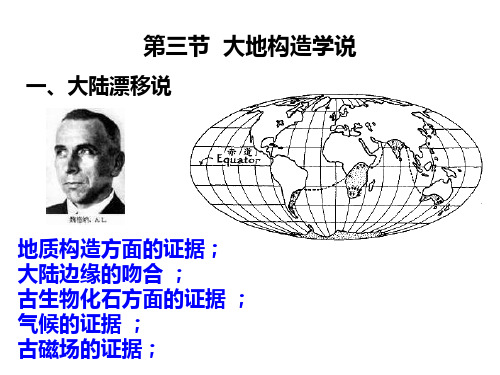
• 在上述现象的发现后,赫斯和迪茨首先提出了 海底扩张理论。
三、板块构造学说
• 地表岩石圈分为若 干不连续的板块, 板块内部稳定,边 缘为活动带,大陆 边缘并非板块边界。
板块的边界有三种类型:
• 扩张型(或增生)边界:新地壳增深的地方, 喷出物多为玄武岩,以张应力产生的正断层和 节理为主。
全新世 1万年 第四纪Q 更新世 260万年
新生代Cz 新近纪N 古近纪E
上新世 中新世 渐新世 始新世 古新世
530万年 2330万年 3200万年 5650万年 6500万年
二、海底扩张学说
➢ 海底扩张学说来源于二战后对洋底调查所发现 的现象部位,是岩石圈的巨型张裂谷,也是岩浆的涌 出口和地热排泄口。
• 构造体系是地质力学的基本概念。它是指“许 多不同形态、不同性质、不同等级和不同次序, 但具有成生联系的各项结构要素所组成的构造 带以及它们之间所夹的岩块或地块组合而成的 总体”
• 构造体系可划分为三种基本类型(型式):纬 向构造体系,经向构造体系,扭动构造体系。
槽演化而来。 • 地槽是地壳活动强烈的地带,在地表呈长条状
分布,升降幅度大,岩浆活动敏频繁。 • 地台则是地壳稳定区域,构造变动与岩浆活动
较弱。
五、地质力学学说
• 地质力学学说是地质学家李 四光创立的,其基本观点是: 全球地质构造的展布不是乱 杂无章的,而具有一定的方 向和方位。这是在地壳运动 的一定动力方式作用下,形 成了相应形式的构造应力场 的结果,从而产生出一定方 向和方位的构造体系。
第三节 大地构造学说
一、大陆漂移说
地质构造方面的证据; 大陆边缘的吻合 ; 古生物化石方面的证据 ; 气候的证据 ; 古磁场的证据;
石大远程奥鹏-大地构造学-第二阶段在线作业正确答案
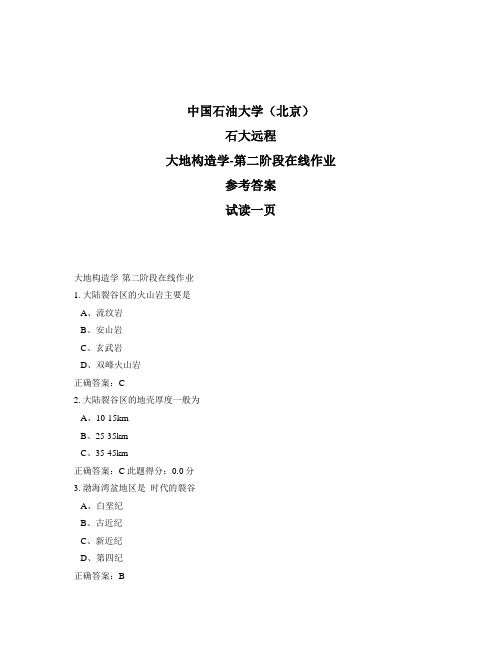
B、中压
C、高温
正确答案:A
15. 蓝晶石一般出现在_变质相系
A、高压
B、中压
C、高温
正确答案:A
16. 红柱石一般出现在_变质相系
A、高压
B、中压
C、高温
正确答案:C
17. 构造沉降量大约是总沉降量的
A、三分之一
B、三分之二
C、五分之一
正确答案:A
18. 珠穆朗玛峰平均上升的速度约为_量级
A、俯冲带
B、蛇绿岩套
C、造山带
D、地震带
正确答案:B
22. 哪两个板块的运动速度最快
A、太平洋板块和菲律宾板块
B、太平洋板块与欧亚板块
C、太平洋板块与纳兹卡板块
正确答案:C
23. 板块的绝对运动是指板块相对于_的运动
A、地球自转轴
B、赤道
C、地球上某一点
正确答案:A
24. 威尔逊旋回胚胎期的代表是
A、大陆裂谷
B、幼年洋盆
C、残余小洋盆
正确答案:A
2过渡壳
C、洋壳
正确答案:B
26. 圣安德烈斯断层区的大地构造环境是
A、被动陆缘
B、转换断层
C、活动大陆边缘
正确答案:B
27. 日本的大地构造环境是什么
A、被动陆缘
B、新生大陆边缘
C、火山弧
正确答案:C
28. 大陆裂谷的沉积是
C、印度洋周缘
正确答案:B
7. 被动大陆边缘的沉积物主要是
A、陆相
B、海陆过渡相
C、海相
正确答案:C
8. 形成岩浆的主要因素是
A、构造因素
B、放射性
C、有热源
正确答案:A
大地构造学说
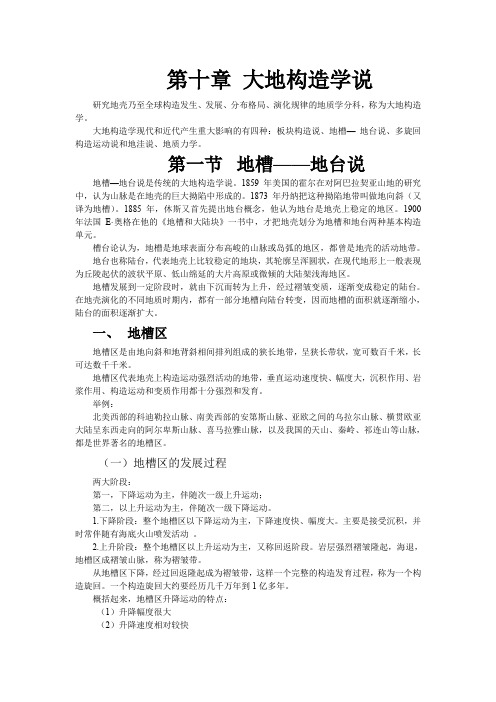
第十章大地构造学说研究地壳乃至全球构造发生、发展、分布格局、演化规律的地质学分科,称为大地构造学。
大地构造学现代和近代产生重大影响的有四种:板块构造说、地槽—地台说、多旋回构造运动说和地洼说、地质力学。
第一节地槽——地台说地槽—地台说是传统的大地构造学说。
1859年美国的霍尔在对阿巴拉契亚山地的研究中,认为山脉是在地壳的巨大拗陷中形成的。
1873年丹纳把这种拗陷地带叫做地向斜(又译为地槽)。
1885年,休斯又首先提出地台概念,他认为地台是地壳上稳定的地区。
1900年法国E·奥格在他的《地槽和大陆块》一书中,才把地壳划分为地槽和地台两种基本构造单元。
槽台论认为,地槽是地球表面分布高峻的山脉或岛弧的地区,都曾是地壳的活动地带。
地台也称陆台,代表地壳上比较稳定的地块,其轮廓呈浑圆状,在现代地形上一般表现为丘陵起伏的波状平原、低山绵延的大片高原或微倾的大陆架浅海地区。
地槽发展到一定阶段时,就由下沉而转为上升,经过褶皱变质,逐渐变成稳定的陆台。
在地壳演化的不同地质时期内,都有一部分地槽向陆台转变,因而地槽的面积就逐渐缩小,陆台的面积逐渐扩大。
一、地槽区地槽区是由地向斜和地背斜相间排列组成的狭长地带,呈狭长带状,宽可数百千米,长可达数千千米。
地槽区代表地壳上构造运动强烈活动的地带,垂直运动速度快、幅度大,沉积作用、岩浆作用、构造运动和变质作用都十分强烈和发育。
举例:北美西部的科迪勒拉山脉、南美西部的安第斯山脉、亚欧之间的乌拉尔山脉、横贯欧亚大陆呈东西走向的阿尔卑斯山脉、喜马拉雅山脉,以及我国的天山、秦岭、祁连山等山脉,都是世界著名的地槽区。
(一)地槽区的发展过程两大阶段:第一,下降运动为主,伴随次一级上升运动;第二,以上升运动为主,伴随次一级下降运动。
1.下降阶段:整个地槽区以下降运动为主,下降速度快、幅度大。
主要是接受沉积,并时常伴随有海底火山喷发活动。
2.上升阶段:整个地槽区以上升运动为主,又称回返阶段。
大地构造学若干常见问题答疑(2)

大地构造学若干常见问题答疑(2)胡经国十一、地质力学基本特征地质力学(Geomechanics)的基本特征如下:1、实践观点任何一种地壳构造运动的正确假说都必须能够完满地说明客观地质现象,必须接受客观地质构造实际的严格检验;地质构造是探索地壳构造运动的主要研究客体。
2、本质观点各种地质构造大都是力作用的直接结果。
它们都有一定的力学属性和力学本质。
查明地质构造的力学性质就成为首要的基础性工作。
3、联系观点任何地质构造现象都不是孤立存在的。
在它的发生和发展过程中,必定有其不可分割的伴侣;成群成带相伴出现的地质构造现象的总体,构成统一的构造体系。
十二、地质力学研究地壳运动的步骤1、鉴定结构要素的力学性质;2、辨别构造形迹的序次和不同序次结构面力学性质的转变;3、确定构造体系的存在和范围;4、划分巨型构造带,鉴定构造型式;5、分析联合和复合的构造体系;6、探讨岩石力学性质和各类型构造体系反映的应力活动方式;7、构造模拟实验。
十三、三重基本概念地质力学的三重基本概念,是指构造要素、构造地块和构造体系。
1、构造要素构造要素,是指在地质体中的基本构造形迹或标志地质构造存在的基本单位。
2、构造地块构造地块具有一定综合结构形态;属于一定构造体系的地质块体,常由地壳物质组成或由地壳结构构造的均一性以及具有明显界限反映出来。
根据规模大小、影响深度、结构形态和活动强度,构造地块可以分为块垒地和褶皱地。
3、构造体系构造体系,是指具有成生联系的各项不同形态、不同等级、不同性质和不同序次的构造要素所组成的构造带、以及它们之间所夹地块或岩块组合而成的总体。
(每种构造体系都不是孤立存在的,在其形成过程中必定有不可分割的伴侣成群出现)十四、构造体系三大特征1、定型性具有共同组合形态特征,构成一定的标准构造型式;2、定位性所属构造带常在一定部位出现,其配置符合一定规律;3、定向性各类构造体系多沿一定方向展布。
十五、沉积盆地类型和特征1、裂陷构造环境的盆地(1)大陆内裂谷盆地这种盆地内的主要沉积物以普遍发育火山活动为特征,主要为大陆环境的河湖相碎屑沉积;晚期可能有海水入侵,形成海陆交互相碎屑岩和碳酸盐沉积。
第2章 大地构造学(板块构造理论—2岩石圈及岩石圈板块)

软流圈(低速层)
对陆壳成分结构的新认识 (主要针对下地壳成分)
超深钻钻探表明,地壳内部可能不存在康拉德面 (硅铝/硅镁)---科拉半岛设计15km,钻至 11.5km结束,原预测的7km深处的康拉德面并不 存在,在该深度以下仍为斜长片麻岩、花岗片麻 岩和角闪岩 ,只是随着深度增加角闪岩夹层增多。 而不是“玄武岩层” 剥露到地表的麻粒岩相下地壳成分往往以长英质 片麻岩、麻粒岩为主体。 很多新的火山岩携带的大量下地壳包体往往也以 长英质片麻岩、麻粒岩为主体。
因此,陆壳的下地壳成分可能仍以长英质或花 岗质成分为主。
大陆岩石圈成分的不均一性
大陆岩石圈的组成和物性变化很大,缺乏一
个共同的成因方式,大陆岩石圈的组成上部是 由非均一成分和具有复杂构造和热演化史的不 同块体拼合而成,因而它们具有不同的强度。 大陆下地壳的性质因地而异,不同的性质造成 了复杂多样的效应与结果,诸如活动断裂带的 宽度、造山带高度、沉积盆地以及被动大陆边 缘的下沉速度的差异等.
岩石圈的化学结构
大陆地壳:复杂的成分结构 地幔岩石圈:多认为是橄榄石、辉石和石榴石的 某种组合 壳幔的化学过程:主要通过几个方面研究: 玄武质岩石的信息 花岗质岩石的信息 捕虏体与捕虏晶的研究:岩石探针 流体包裹体的研究
•通过观察来自岩石圈深处的岩石,了解深部特征
岩石圈深部岩石到达地表的方式 •构造剥露(如逆冲岩席)
• 1960,5,22 智利8.9级大地震,发现全球 大部分地区存在低速层。
地 震 波 显 示 的 地 幔 结 构 和 不 连 续 面
岩石圈lithosphere
• 地球上上部(外层)刚性的部分,实际上 包括地壳和刚性上地幔部分。也有人用 1300°等温面以上的圈层。 • 刚性:厚50-200km • 成分径向变化:上部-花岗岩和玄武岩; 下部-橄榄岩、辉橄岩 • 被地震活动带分割成若干块体
2-3大地构造学说

1.基本观点: ①现在的大陆在2亿前年是联合在一起的,此 后才逐渐分开。 ②大陆移动的形式是硅铝质陆块在硅镁质洋块 上浮移。 ③漂移的动力是地球自转产生的离心力和其他 天体对地球表面的引力。
2.主要证据 ①魏格纳(A.Wegener)的证据 大陆漂移学说首先是德国气象学家A.Wegener 于1912年提出来的。其主要证据是大西洋两岸 的陆地轮廓吻合性以及地层、构造、古生物、 古气候和冰川等其他现象的相似性、相关性和 连续性。 ②五十年代以后的新证据 • A.各大陆岩石的古地磁极与现代地磁极不重合当前学术界最有影响的 一个大地构造学说。
人6 米 裂 “而 大 大 道 是 形, , 谷 东神 无 陆 巨 世 象气 谷 宽 非奇 朋 的 大 界 地势 壁 约 大的 的 赤 的 大 将宏 如 几 峡感 “ 道 伤 陆 其伟 刀 十 谷觉 刀 上 疤 上 称, 削 至 ”, 痕 空 。 最 为景 斧 2 或这 ” 时 当 大 “色 劈 0 “就 呈 , 乘 的 地壮 一 0 东是 现 从 飞 断 球观 般 公 非著 在 机 机 裂 表, , 里 大名 眼 窗 越 带 皮是 长 , 地的 前 向 过 , 上世 度 深 沟“ , 下 浩 从 的界 相 达 ”东 顿 俯 翰 卫 一上 当 1 。非 时 视 的 星 条最 于 0 大 让 , 印 照 大大 地 0 裂 人 地 度 片 伤的 球 0 谷 产 面 洋 上 痕裂 周 至 ” 生 上 , 看 ”谷 长 2 , 一 有 进 去 。带 的 0 亦 种 一 入 犹 ,10 称惊条东如 异硕非一 有/0
•
前边已经说过,海底扩张的速度为1-5cm/ 年,据此计算在1-2亿年中,海底扩张的速度 可达几千公里,整个洋底可以更换一次。所以 在大洋地壳中不可能发现1.9亿年以前的岩石。 以前的岩石那里了,俯冲到了地幔中又变地幔 物质。 最近的研究表明,洋底的年龄中央岭脊处 最年轻,向两侧逐渐变老,并呈对称分布。
大地构造学

--板块构造及沉积盆地
一、基本概念
大地构造学(Tectonics/Geotectonics):是 研究岩石圈组成、结构、运动(包括变形 和变位)和演化的一门综合性很强的构造 地质学分支学科。(万天丰,2004)。
大地构造学是以整个地球和整个岩石圈作 为研究对象,也可称为全球构造学,侧重 于理论方面的研究,因而富于推理性和探 索性。其基础为区域大地构造学。
主要参考书目 杨桥.2004.地球科学概论.石油工业出版社. 陆克政等.2001.含油气盆地分析.石油工业出版社. 张恺.1995.中国大陆板块构造与含油气盆地评价.石油工业出版社.
Davies.G.F.1999.Dynamic and Mantle Convection. Cambridge: Cambridge University Press. 杨森楠,杨巍然。1985。中国区域大地构造学。地质出版社。 程裕淇。1994。中国区域构造概论。地质出版社。 张宗命。1982。中国石油大地构造学。石油工业出版社。
示盆地内石油生成的数量与热体制有关。盆地 内温度高不仅有利于石油生成,而且有利于油 气运移。
热流值的常用对数衰变值(据Dickinson)
盆地沉积类型和构造型式在很大程度上取 决于盆地的板块构造位置
自青海高原至四国海盆剖面,示地壳分异及 第三纪以来沉积发展(据王鸿祯)。 东部为过渡型地壳盆地,沉积类型属外海、边缘海和活 动陆棚类型沉积,然后从东而西为大陆地壳盆地类型, 分别属近海盆地、内陆盆地和山间盆地类型沉积。
国内外大地构造学的理论体系,有以下四种:
1)以区域地质学为主线:
杨森楠,杨巍然,1985,中国区域大地构造学,地质出版社。
程裕淇,1994式为主线:
世界大地构造学2(28页)
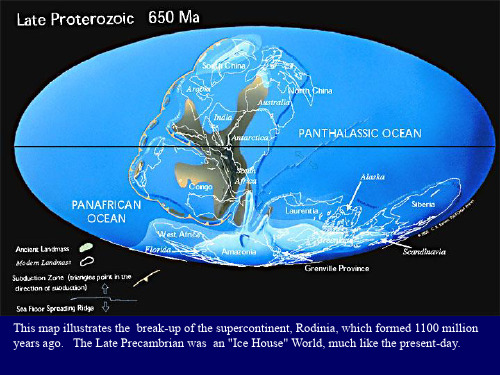
When the Earth is in its "Ice House" climate mode, there is ice at the poles. The polar ice sheet expands and contacts because of variations in the Earth's orbit (Milankovitch cycles). The last expansion of the polar ice sheets took place about 18,000 years ago.
Laurentia collides with Baltica closing the northen branch of the Iapetus Ocean and forming the "Old Red Sandstone" continent. Coral reefs expand and land plants begin to colonize the barren continents.
During the Early Carboniferous the Paleozoic oceans between Euramerica and Gondwana began to close, forming the Appalachian and Variscan mountains. An ice cap grew at the South Pole as four-legged vertebrates evolved in the coal swamps near the Equator.
This map illustrates the break-up of the supercontinent, Rodinia, which formed 1100 million years ago. The Late Precambrian was an "Ice House" World, much like the present-day.
- 1、下载文档前请自行甄别文档内容的完整性,平台不提供额外的编辑、内容补充、找答案等附加服务。
- 2、"仅部分预览"的文档,不可在线预览部分如存在完整性等问题,可反馈申请退款(可完整预览的文档不适用该条件!)。
- 3、如文档侵犯您的权益,请联系客服反馈,我们会尽快为您处理(人工客服工作时间:9:00-18:30)。
Laurentia collides with Baltica closing the northen branch of the Iapetus Ocean and forming the "Old Red Sandstone" continent. Coral reefs expand and land plants begin to colonize the barren continents.
Vast deserts covered western Pangea during the Permian as reptiles spread across the face of the supercontinent. 99% of all life perished during the extinction event that marked the end of the Paleozoic Era.
During the Early Carboniferous Pangea Begins to Form.
By the Late Carboniferous the continents that make up modern North America and Europe had collided with the southern continents of Gondwana to form the western half of Pangea. Ice covered much of the southern hemisphere and vast coal swamps formed along the equator.
By the Devonian the early Paleozoic oceans were closing, forming a "pre-Pangea". Freshwater fish were able to migrate from the southern hemisphere continents to North America and Europe. Forests grew for the first time in the equatorial regions of Artic Canada.
During the Early Carboniferous the Paleozoic oceans between Euramerica and Gondwana began to close, forming the Appalachian and Variscan mountains. An ice cap grew at the South Pole as four-legged vertebrates evolved in the coal swamps near the Equator.
By the Early Jurassic, south-central Asia had assembled. A wide Tethys ocean separated the northe continents from Gondwana. Though Pangea was intact, the first rumblings of continental break up could be heard.
ቤተ መጻሕፍቲ ባይዱ
The supercontinent of Pangea began to break apart in the Middle Jurassic. In the Late Jurassic the Central Atlantic Ocean was a narrow ocean separating Africa from eastern North America. Eastern Gondwana had begun to separate form Western Gondwana.
Animals with hard-shells appeared in great numbers for the first time during the Cambrian. The continents were flooded by shallow seas. The supercontinent of Gondwana had just formed and was located near the South Pole.
The supercontinent of Pangea, mostly assembled by the Triassic, allowed land animals to migrate from the South Pole to the North Pole. Life began to rediversify after the great Permo-Triassic extinction and warm-water faunas spread across Tethys.
This map illustrates the break-up of the supercontinent, Rodinia, which formed 1100 million years ago. The Late Precambrian was an "Ice House" World, much like the present-day.
During the Ordovician ancient oceans separated the barren continents of Laurentia, Baltica, Siberia and Gondwana. The end of the Ordovician was one of the coldest times in Earth history. Ice covered much of the southern region of Gondwana.
